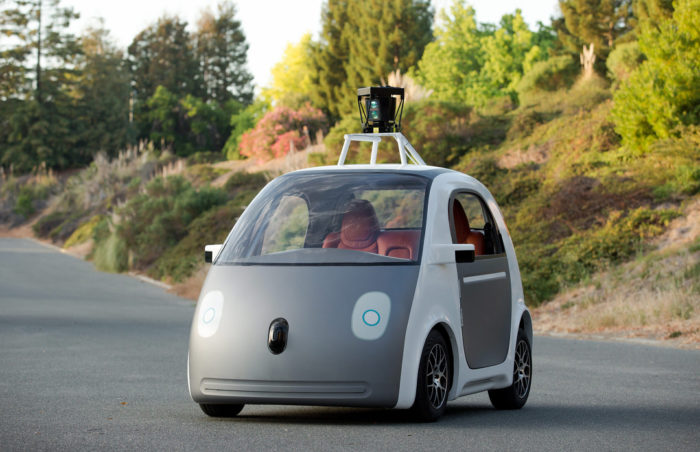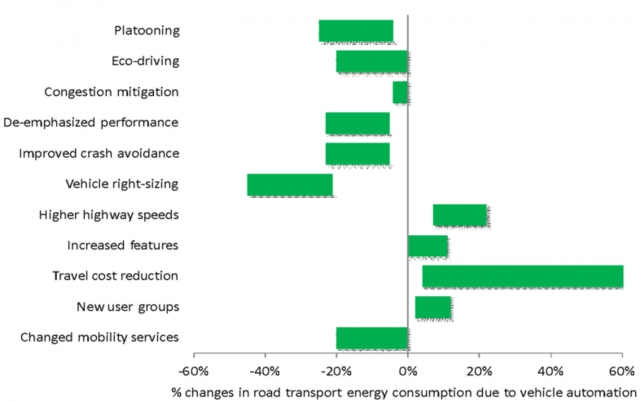
Image Credit: Smoothgroover22 / CC / Flickr
I started to learn to drive only three years ago, and — inevitably — failed my first test. Naturally, I was disappointed. But then it occurred to me that I could avoid the whole issue, if only I could get my hands on a driverless car. And this triggered the research question: what would the overall impact on travel demand, energy use, and carbon emissions be if driverless cars were readily available to the likes of you and me?
I joined two like-minded academics in the U.S. — Don MacKenzie and Paul Leiby — to research how the automation of road transport might affect energy use, and to quantify the potential range of these impacts.
We found that a widespread adoption of self-driving vehicles could indeed help to reduce energy consumption in a number of ways. For example, on motorways, automated vehicles can interact with each other and drive very closely as a “platoon.” This can reduce the total energy consumption of road transport by 4% to 25%, because vehicles which follow closely behind each other face less air resistance.
What’s more, when vehicles can interact with each other and road infrastructure — such as traffic control systems — this will smooth out the traffic flow. The result will be less congestion and a reduction in energy use of up to 4%. On top of this, automated “ecodriving” — a driving style which controls speed and acceleration for more efficient fuel use — can reduce energy use by up to 20%.
When you are riding in your self-driving car, obviously you won’t be at the controls, so you will no longer be able to enjoy the rapid acceleration of your driving days — so perhaps the desire for more powerful engines could diminish. And given that vehicle safety is expected to improve dramatically in self-driving cars, some of the heavy safety features could be removed, making cars lighter. Each of these changes could reduce energy use by up to 23%.
The bigger picture
So far, so good — all of these mechanisms improve the efficiency with which a car travels. But, as a society, our interest lies in reducing total energy use, or total carbon emissions — and energy efficiency forms only one half of this picture. Our total carbon emissions also depend on the demand for travel. So, while improving the energy efficiency of cars by automating the driving process will reduce the carbon emissions of individual vehicles, the overall impact of this change will depend on how many people use them.
For instance, consider what would happen if large numbers of people switched to self-driving cars from traveling by train. We generally prefer the privacy and convenience of traveling by car, but using public transport means we can concentrate on other stuff — such as reading a book or getting some work done. A self-driving car offers all of these benefits. As a result, we found that driverless cars could prove so attractive that they increase car travel by up to 60% in the US.
As you can see in the graphic below, the features of driverless cars may have a range of impacts on energy consumption — both positive and negative.

Self-driving cars could also encourage a completely new group of people to own vehicles — for example, the elderly, the disabled, and possibly those too young to drive themselves. This would increase the welfare of that demographic by giving them greater mobility. Yet travel demand, energy use and carbon emissions would all rise: our estimate for the U.S. is an increase between 2% and 10%.
Sharing is caring
But it’s not all bad news: self-driving cars could encourage a move away from current car-owning culture to a car-sharing or on-demand culture. This opens up a few different possibilities. For one thing, by making the per-mile costs more visible to the user, car sharing or automated taxis could reduce travel demand from individuals. Yet these shared automated cars may still travel empty for some parts of their trips, so this option could lead a reduction of energy use between 0% to 20%.
But even greater energy savings are possible if the size of the self-driven shared car is matched to the trip type: for example, if a one-person commute trip is undertaken by a compact car, while for a family leisure trip a medium-sized sedan is used. This approach could reduce energy demand by 21% to 45%.
One thing we haven’t touched in great detail is the potential for self-driving cars to encourage a switch to alternate fuels such as electricity and reduce carbon emissions. Imagine the car dropping you off at your destination and finding a charging point to recharge itself.
So, automation does have the potential to reduce energy use for road transport. But this is not a direct result of automation per se; rather, it is due to how automation changes vehicle design, operations, and ownership culture. It’s also interesting that some of the energy-saving benefits of self-driving cars are possible at a lower level of automation, through increased interaction between vehicles and infrastructure.
It is clear that the benefits of self-driving cars will depend on how we use them. The widespread adoption of automated vehicles could well have some unexpected effects, so it’s vital that we find and implement ways to realize the full energy-saving and carbon-reducing potential of self-driving cars. Until then, we’d better keep practicing our driving.
Zia Wadud is an associate professor in transport and energy at the University of Leeds. This post originally appeared at The Conversation.
Weekly Newsletter
Get building science and energy efficiency advice, plus special offers, in your inbox.















9 Comments
More gov't control of our lives in the name of the environment?
I'm suspect of self-driving cars and the systems used to control them. Perhaps I'd consider it if there was a manual (physical switch) override because I'd rather not live in the world similar to that of George Orewells 1984.
IMO self-driving cars is just a way for Google et al to make their way into that last island of privacy, your vehicle and they're going to use the police force of The State to get there.
All true....
And, if cars are electric and smart enough to seek out power points, they could act as an enabler of 100% renewable power grid...
All in all, there are dizzying possibilities for good... and plenty on the downside as well. We shall just have to wait and see, eh? Interesting times!
long time off
Google's project director, Chris Urmson, says that fully autonomous cars may be as far off as 30 years. He says that the rollout will likely be in stages with early versions limited by weather, geography, and traffic conditions. For example, would an autonomous car be able to come upon an accident and recognize a policeman giving hand directions and follow the directions? Driving is a pretty complex thing.
No doubt there are great efficiencies to be had with fully autonomous cars cooperating at intersections. No lights would be needed, but non-autonomous pedestrians, motorcycles, and bicycles would be at an even greater disadvantage.
Travel will increase, but the
Travel will increase, but the ability to install more solar panels means no need to increase use of fossil fuels.The end of gridlock traffic will be very nice.
If travel increases too much we may need to go with a pubic transport model because doubling or tripling the number of cars on the road will lead back to congestion.
Winter driving
My understanding is that there are still no technical solutions to all of the problems associated with programming a self-driving car to handle snowy and icy conditions. How do you find the edges of the road when everything is white?
In other words, these cars may work in parts of California, but we aren't going to see them in Vermont.
@ Martin
They will be equipped with GPS, but the accuracy is probably not quite at the edge of a cliff accuracy, though it knows what lane its in.
Response to Alan B
Alan,
As you point out, the accuracy of GPS navigation is insufficient to address all the issues surrounding winter driving. I don't doubt that these technical issues will be resolved one day, but there will be a lot of Google cars spinning their wheels on the side of the road, stuck in ditches, before all of these issues are ironed out.
GPS navigation doesn't work very well on gravel roads in rural areas, as rural residents know well. Most GPS systems are inaccurate in rural areas, and often direct trucks onto roads that aren't maintained by the local town. Moreover, local road crews adjust the width and location of rural roads all the time, using a grader to push around the gravel -- making the roads wider or narrower as conditions warrant. Who upgrades the GPS information when this happens?
More Life = Less Living
Add automated cars to the thousands and thousands of examples showing that there are simply far too many of us on this planet. Without the extreme over-population that has already existed for years,
the constant flow of new restrictions that lessen the quality of life, and the constant struggle to increase efficiency asymptotically, would not need to happen.
Here's the good news for anyone alive now and reading this, who would quickly dismiss my point as ridiculous. There's a good possibility that you will be dead before you would really need to wake up, take off the blinders and rosy glasses, to finally see the reality.
Uber as a reference point
Thanks for a really good examination of this issue, including the effects in both directions with quantification. I also appreciate acknowlegement that it is not just a question of predicting what the effect will be--there are choices about how we use the new capabilities: individual choices, cultural shifts, and policy choices will affect how it develops.
The ways in which Uber is developing and being used offer some insight into how similar services from driverless cars might be used. This NY Times article discusses the surprisingly rapid development and success of Uber's "pool" option for well organized shared rides that don't delay the passengers much but save them money and reduce emissions, and the fact that data hint that Uber users are using combinations of Uber and transit, rather than turning away from transit. Both of those are encouraging, although the data on combining Uber and transit are nothing near conclusive.
Log in or create an account to post a comment.
Sign up Log in